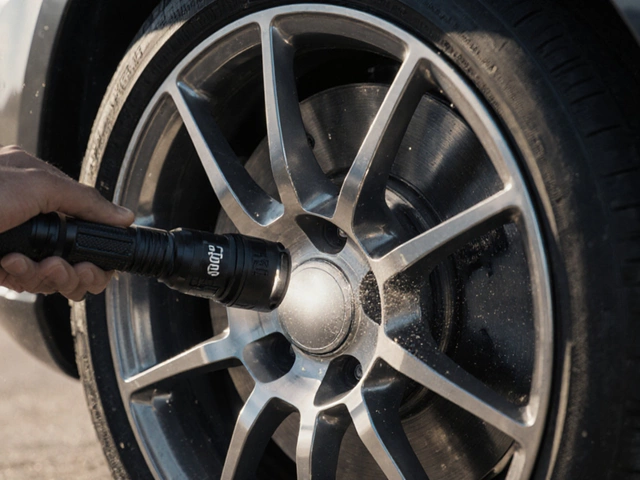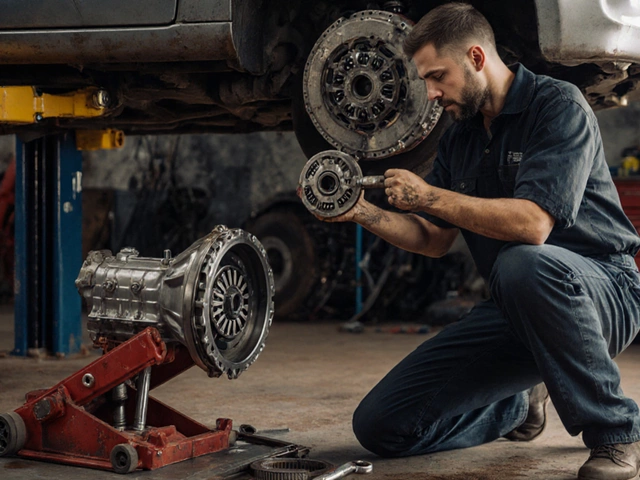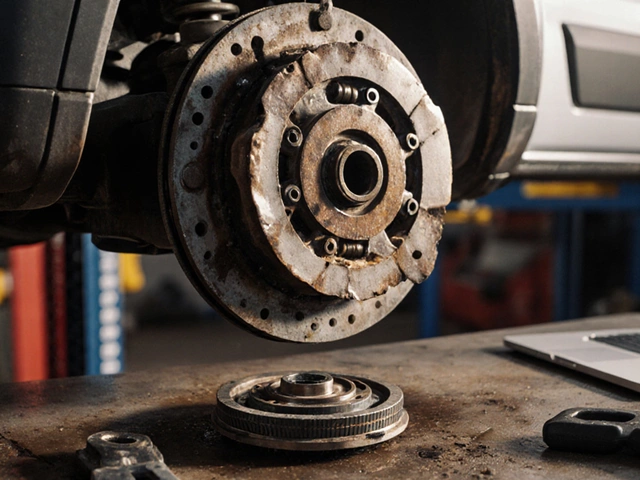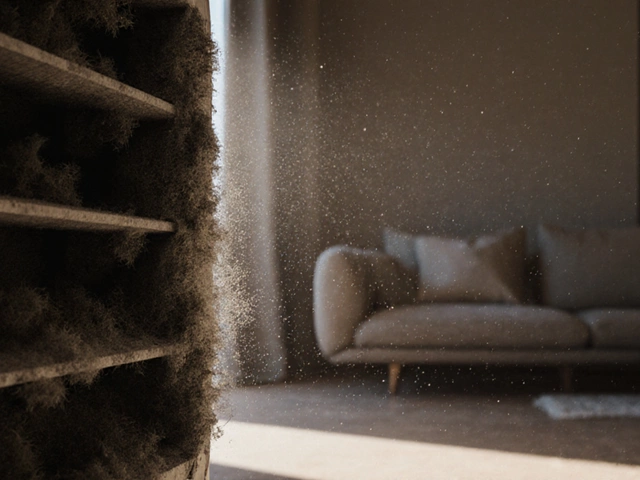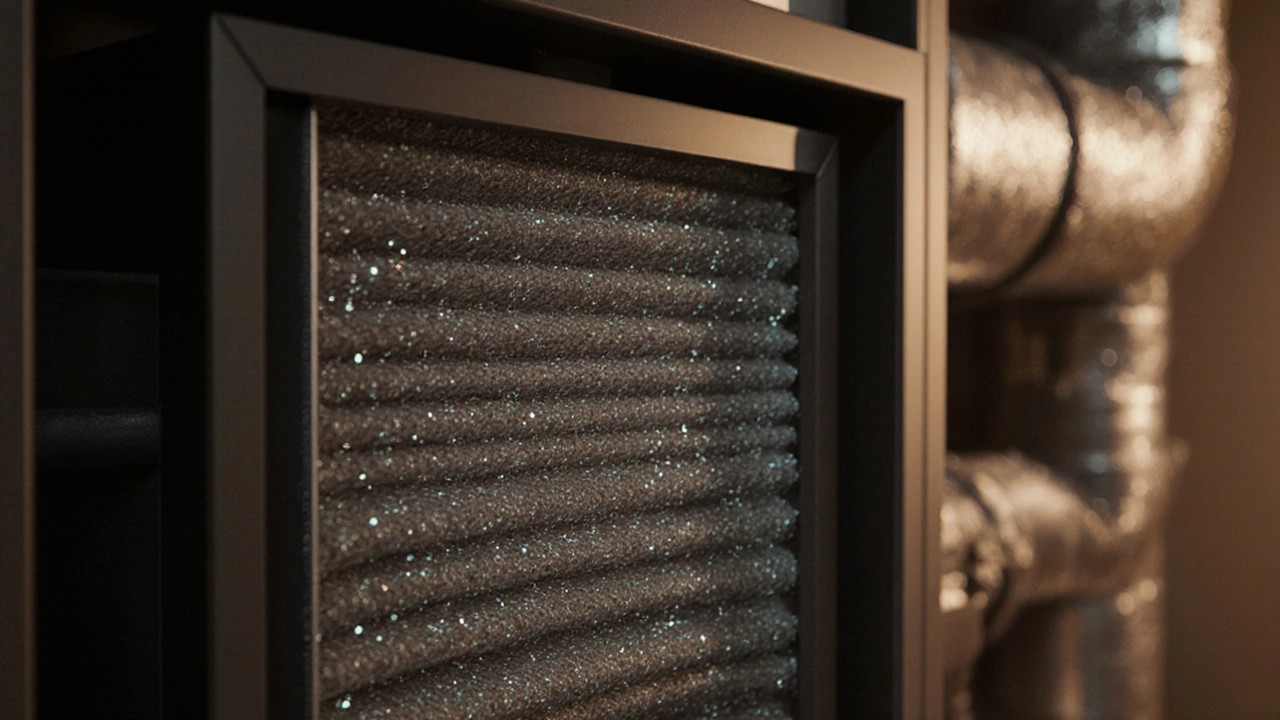
MERV Filter Compatibility Checker
MERV Rating Guide
Quick Take
- MERV 13 filter catches most allergens, smoke particles and some viruses.
- Modern residential HVAC units usually can handle it, but older or undersized systems may see reduced airflow.
- Higher filtration means a slightly higher fan load and a shorter filter lifespan.
- Use MERV 13 in homes with asthma, pets, or in areas with wildfire smoke; otherwise MERV 8‑11 often suffices.
- Check your system’s manufacturer specs for maximum pressure drop before upgrading.
What a MERV 13 filter is and why it matters
When you hear "MERV 13," think of a filter that can snag particles as small as 0.3‑1 microns - roughly the size of pollen, dust mite droppings, and even some virus‑laden droplets. In plain English, it’s a step up from the typical 80‑percent efficient filters found in most new homes.
The filter’s ability to trap tiny particles is measured by the MERV rating, a scale created by the American Society of Heating, Refrigerating and Air‑Conditioning Engineers (ASHRAE). The higher the number, the finer the particles it can capture.
How the MERV scale works
The scale runs from 1 (very coarse) to 16 (near‑HEPA). Here’s a quick snapshot:
- MERV 1‑4: Catches lint and hair.
- MERV 5‑8: Stops larger dust, pollen, and carpet fibers.
- MERV 9‑12: Grabs smaller dust, mold spores, and some bacteria.
- MERV 13‑16: Targets smoke, smog, virus‑size particles, and most allergens.
Because the filter’s media gets denser at higher ratings, it also creates more resistance to airflow - a factor that decides whether your home’s system can comfortably push air through.
Can a typical home HVAC system handle MERV 13?
Most residential units sold after 2010 are designed for a maximum pressure drop of about 0.5 to 1.0 inches of water gauge (in.wg). A standard MERV 13 filter usually sits around 0.3‑0.5in.wg, which many modern furnaces and air‑handlers can accommodate without a noticeable dip in comfort.
Older units, especially those that are undersized for the home’s square footage, may struggle. The fan has to work harder, which can:
- Reduce the volume of air (CFM) reaching each room.
- Raise energy consumption by 5‑10%.
- Cause the system to short‑cycle, leading to premature wear.
Before you swap in a MERV 13, locate the fan’s airflow rating (usually printed on the blower housing) and compare it to the filter’s pressure drop. If the numbers are close, you may need a higher‑capacity fan or a variable‑speed motor.
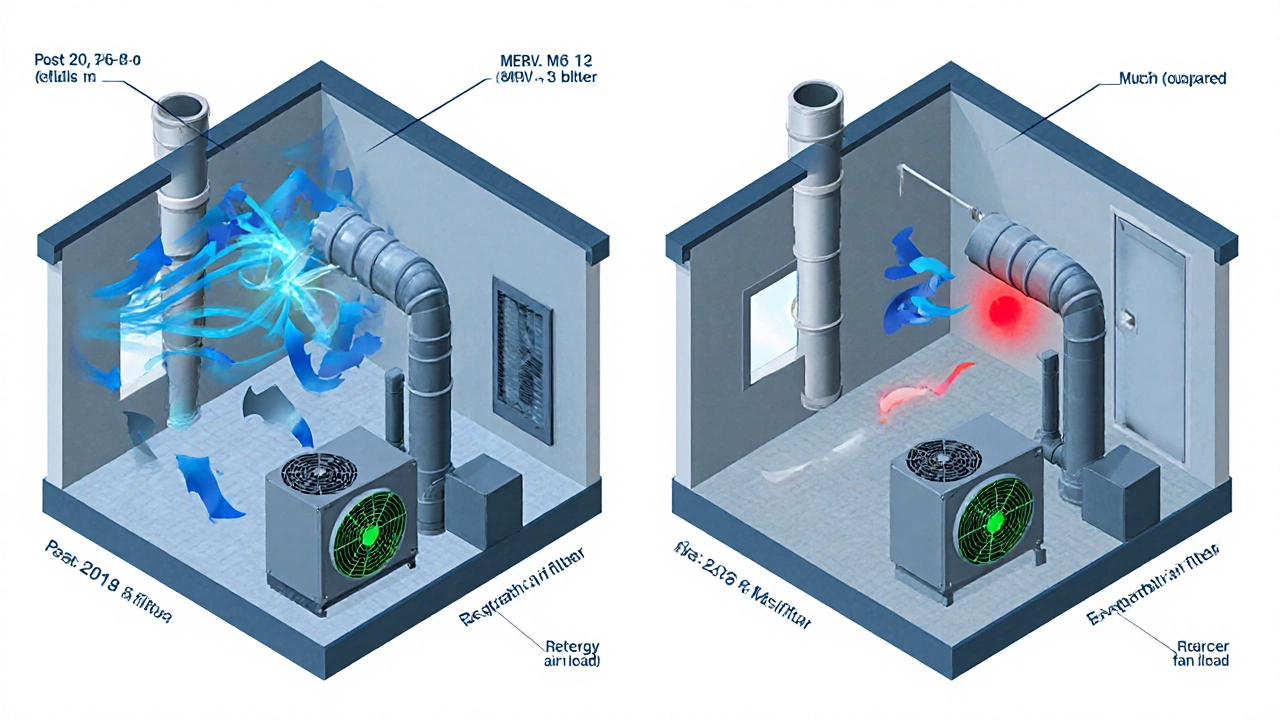
Benefits of stepping up to MERV 13
For families dealing with allergies, asthma, or pet dander, the extra filtration can be a game‑changer. A study from the EPA in 2023 showed a 30‑percent reduction in indoor particulate matter when homes moved from MERV 8 to MERV 13. The same study noted a measurable drop in respiratory symptom scores for occupants with asthma.
Other tangible perks include:
- Smoke and wildfire protection: MERV 13 can capture up to 85% of smoke particles, which is crucial for regions facing seasonal fire events.
- Virus mitigation: While not a substitute for HEPA, it filters out a significant share of aerosolized viruses - a reason many schools upgraded during the COVID‑19 pandemic.
- Cleaner ducts: Fewer particles pass downstream, so long‑term duct cleaning costs may drop.
Drawbacks - when MERV 13 might be too much
The main trade‑off is airflow restriction. If your system’s fan is already near its maximum capacity, adding a tighter filter can cause:
- Reduced heating or cooling output, especially on hot days.
- A slight increase in utility bills due to the fan’s higher workload.
- More frequent filter changes - MERV 13 filters often need swapping every 3‑6months, compared to 6‑12months for lower‑rated media.
Another hidden cost is noise. Higher pressure drop can make the blower hum louder, which some homeowners notice in quiet bedrooms.
Choosing the right MERV rating for your home
Think of the decision as a balancing act:
- Assess occupant health needs: Asthmatic or allergy‑prone residents usually benefit from MERV 13 or higher.
- Check HVAC specifications: Look for the manufacturer’s recommended maximum MERV. If it says "up to MERV 11," stay below that unless you upgrade the fan.
- Consider local air quality: Wildfire‑prone zones or cities with high PM2.5 levels make MERV 13 a sensible defensive layer.
- Factor in budget: Higher‑rated filters cost 2‑3× more per unit and need more frequent replacement.
When in doubt, a good rule of thumb is to start with MERV 11. If your system runs smoothly and you still want extra protection, upgrade to MERV 13.
Installation and maintenance best practices
Getting the most out of a MERV 13 filter is mostly about proper fit and timing:
- Seal the edges: Some filters come with a foil gasket. Make sure it presses firmly against the frame to prevent air bypass.
- Check the orientation: Airflow arrows on the filter should point toward the blower.
- Set a reminder: Mark your calendar for a 3‑month check. Inspect the filter’s surface; if it looks dark or clogged, replace it.
- Watch the thermostat: If you notice the temperature lagging after a filter change, the filter may be restricting flow - consider stepping down one MERV level.
Side‑by‑side comparison of common residential MERV ratings
| Rating | Particle size captured (µm) | Typical pressure drop (in.wg) | Recommended for | Filter lifespan |
|---|---|---|---|---|
| MERV 8 | 3‑10 | 0.1‑0.2 | General homes, budget‑focused | 6‑12months |
| MERV 11 | d>1‑3 | 0.2‑0.3 | Allergy‑sensitive occupants, modest HVAC | 4‑8months |
| MERV 13 | 0.3‑1 | 0.3‑0.5 | Asthma, wildfire smoke zones, high‑risk environments | 3‑6months |
| MERV 16 (HEPA‑like) | 0.1‑0.3 | 0.5‑0.7 | Medical facilities, labs, ultra‑clean homes | 1‑3months |

Frequently Asked Questions
Will a MERV 13 filter make my furnace overheat?
If the furnace’s blower is undersized, the extra resistance can cause the unit to run longer, raising surface temperatures. Most modern furnaces have safety cut‑offs, but it’s best to verify the manufacturer’s maximum MERV rating before upgrading.
How often should I replace a MERV 13 filter?
Typical residential use calls for a change every 3‑6months, but heavy smoke, high pet dander, or running the HVAC continuously can shorten that window.
Can I mix MERV 13 filters with a whole‑house humidifier?
Yes, but ensure the humidifier’s water line isn’t blocked by the filter’s tighter media. Some manufacturers provide a bypass slot for humidifiers when using high‑MERV filters.
Is a MERV 13 filter a substitute for a HEPA filter?
Not quite. HEPA filters capture 99.97% of particles down to 0.3µm, while MERV 13 captures about 75‑85% of the same size. For most homes, MERV 13 offers a solid balance of protection and airflow.
Will using MERV 13 increase my energy bill?
Expect a modest rise-roughly 5‑10%-because the fan works harder to push air through the denser filter. The health benefits often outweigh the slight cost bump.

